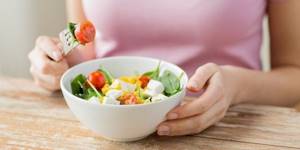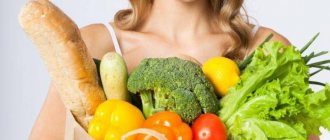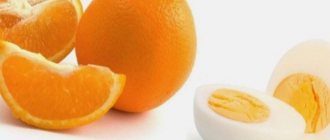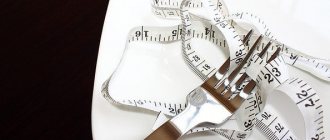January 14, 2011
How is nutrition structured for weight loss in case of obesity, what food should you give up, and what should be left for normal functioning of the body.
It is necessary to fight excess weight. It not only makes a person unattractive, but is a serious risk factor for the development of a huge number of diseases. Including such poorly treatable and potentially fatal ones as heart attack with stroke or even cancerous tumors. However, even if you are truly overweight, the choice of diet for weight loss must be taken very responsibly. The common belief that in order to lose excess weight it is enough to eat almost nothing for a while or even go hungry is a misconception. After all, the goal is not only to lose weight, but also not to harm your health.
A few words about obesity
Obesity is the pathological deposition of fat in the body, which leads to excess weight. There are many types of obesity, but the most common is nutritional: excess weight is a consequence of poor diet, and not the result of nervous or endocrine diseases (see transplanting intestinal bacteria from a healthy person to an obese person can help you lose weight).
Nutritional obesity develops when the calorie content of food consumed exceeds energy expenditure. Body weight and the volume of subcutaneous fat gradually increase, which is distributed approximately equally.
There are 4 degrees of nutritional obesity:
- I - actual mass is 15-29% more than normal;
- II – excess weight by 30-49%;
- III – weight above normal by 50-100%;
- IV – weight exceeds the norm by more than 100%.
The basis of obesity treatment is a special diet and properly selected physical activity.
You can roughly determine your normal weight using Brock's formula: subtract 100 from your height in centimeters. Of course, this is not an exact value, but a figure to guide you by.
Financial costs of one day of weight loss + kcal
- The approximate price of 1 breakfast is 80 rubles, calories 300.
- 2nd breakfast 20 rubles, 70 kcal.
- Lunch 200 rubles, 500 kcal.
- Afternoon snack 50 rub., 140 kcal.
- Dinner 70 rub., 140 kcal.
Total: the price of one day of weight loss was 420 rubles. Total caloric content is 1150 units.
The total energy value of one day should not exceed 1500 kcal.
When adding spices and oils to salads, you can safely add another 100 calories.
When going to the store, choose seasonal vegetables, the cost of which will be lower, especially those produced domestically. Dairy products can be purchased on special offer, the main thing is shelf life.
- The cost of cottage cheese is 120 rubles per 600 g. A pack of kefir is 40 rubles per liter. 10 eggs 65 rub.
- Fruits: oranges 90 rubles per kg, apples 85 rubles, kiwi 180 rubles, grapefruit 200 rubles.
- Vegetables: potatoes 30 rub. per kg; carrots 56 rubles, onions 35 rubles, cabbage 56 rubles, zucchini 90 rubles.
- Olive oil price per liter 250 rubles.
It is better to purchase products a week in advance from large retail chains such as Pyaterochka or Magnit.

Diet Features 8
In more detail about permitted and prohibited foods below, we will outline the general principles of the nutrient composition of the diet. In general, the diet is considered complete, multifaceted, and the diet is voluminous and nutritious. If all recommendations are followed, the body receives a full range of vitamins, fiber and lipotropic substances that oxidize fats (found in fermented milk products, seafood and soy). The energy value is reduced by reducing fats and fast carbohydrates.
Squirrels
The protein content is within normal limits and provides about 20% of the total daily caloric intake; animal proteins slightly predominate over plant proteins. Buckwheat, cabbage, and radish are optimal sources of vegetable protein. Animal proteins (up to 150 g/day) are lean meats. Pork is limited and fatty meat, as well as meat products, are completely excluded. Fish - low-fat varieties, seafood is welcome.
Carbohydrates
Rapidly absorbed carbohydrates are completely excluded. It is not advisable to use sugar substitutes (xylitol, fructose, sorbitol), which have a high energy value.
It is advisable to consume only carbohydrates with a low glycemic index. Widely used: radishes, fresh cucumbers, cabbage of all types, zucchini, turnips, tomatoes; it is better to eat partially raw. Potatoes, carrots, beets, rutabaga, pumpkin, as well as salted and pickled vegetables are limited. Carbohydrates should be distributed evenly between meals.
Bread is excluded altogether or limited to 100 grams. per day.
Fats
Not only the quantitative fat content is important, but also the qualitative one. Limiting fat to 30% of the calorie intake should be achieved through the introduction of low-fat foods. It is important that the body receives mono- and polyunsaturated fatty acids in equal proportions, which are rich in vegetable oils: flaxseed, olive, mustard.
Fiber and dietary fiber
In order to create a feeling of fullness, the diet increases the content of foods with a high amount of dietary fiber: raw vegetables, bran, herbs. Having low calorie content, they create the required volume and increase the feeling of fullness.
In addition to the diet, fasting monodays are introduced 1-2 times a week with an energy value of about 1000 Kcal:
- apple - up to one and a half kilograms of fresh apples per day;
- cottage cheese - up to half a kilogram of low-fat cottage cheese + 2-3 glasses of green tea;
- watermelon - up to 1.5-2 kilograms of watermelon pulp;
- kefir - up to 1.5 liters of kefir.
General rules
Obesity is defined as excess accumulation of fat resulting from consuming calories that exceed a person's energy expenditure. High intake of carbohydrates and fats plays an important role in its development. The main criterion for diagnosing this condition is the body mass index, which, if it is from 25 to 40 kg/m2, is regarded as obesity of 1-2 degrees, and if it is more than 40 kg/m2, then obesity of extreme 4 degrees occurs. This is already a disease or so-called morbid obesity .
It is accompanied by neurohumoral and metabolic disorders, as well as changes in organ function. The problem is important because many diseases are associated with obesity: metabolic syndrome , diabetes mellitus , hypertension , dyslipidemia , osteoarthritis , sleep apnea and polycystic ovary syndrome . Even a slight excess of weight (just 10%) already leads to an increase in mortality by 20%, increasing the risk of cardiovascular disease and diabetes. Thus, it can be considered as a socially significant disease.
Treating this disease is a difficult task and first of all you need to find out the cause. The formation of excess weight is often associated with eating disorders, which are psychological in nature. For example, in patients suffering from bulimia nervosa. Bulimia is a psychosomatic disorder that manifests itself in uncontrolled food consumption. The second name for this disorder is ravenous hunger. Attacks of overeating are provoked by external influences and the disease can occur in the form of:
- paroxysmal absorption of food as a result of a strong appetite;
- constant consumption of large amounts of food;
- night food, when attacks occur at night.
Most often, the patient tries to get rid of the food he has eaten by vomiting or using enemas and laxatives. Bulimia with addiction to high-carbohydrate foods can occur with depression . In women, during the luteal phase, taste preferences change (a craving for sweets appears), appetite increases and transient bulimia .
Patients in whom decreased satiety is accompanied by anxiety-depressive disorders and bulimia are prescribed antidepressants . Therapy with appetite regulators ( Sibutramine , Dietressa ) is also effective.
A diet for obesity is always prescribed regardless of the cause that caused it. It is based on the principles of a balanced diet - it contains a sufficient amount of protein, vitamins and microelements. At the same time, the diet limits the amount of fat (from animals), salt (up to 3-5 g), easily digestible carbohydrates and free liquid (this depends on the degree of obesity), on average 1-1.2 liters. Any foods that stimulate the appetite are also limited.
It uses low-calorie foods: lean fish, seafood, dietary meat, low-fat cottage cheese, milk, eggs, which contain essential amino acids and vitamins . Non-digestible fiber and complex carbohydrates are represented by vegetables, fruits, cereals and grains. The patient obtains unsaturated fatty acids through the consumption of vegetable oils.
Proper distribution of calories throughout the day is important. This is due to the fact that in the first half of the day fat breakdown processes predominate, and after 18 hours liposynthesis accelerates (especially at night). Taking this into account, breakfast should be the most high-calorie, so it can include complex and simple carbohydrates and protein. Lunch is less high in calories. For dinner, which should be very light, you can eat lean meat/fish with a vegetable side dish. Or cottage cheese with kefir. After dinner you can only drink water or kefir.
The composition of foods, as well as proteins, fats and carbohydrates, varies depending on the degree of obesity, but the basic principles of nutrition are similar:
- Inclusion of vegetables and fruits - sources of fiber and complex carbohydrates. You need to consume them daily, spreading them over all meals, since fiber slows down the absorption of carbohydrates and fats and the process of converting carbohydrates into fats. They also inhibit the rise in post-meal glucose and the spike in insulin that promotes fat storage.
- Mandatory consumption of complex carbohydrates (whole grain bread, muesli, cereals, cereals).
- Introduce protein through lean meats, fish, eggs and dairy products.
- Healthy fats in the diet are represented by vegetable oils.
- Exclusion of simple carbohydrates (sugar, honey, baked goods, etc.). The need for sweets must be met with berries and fruits.
- Avoiding alcohol, flavor enhancers, and processed foods. Nuts, popcorn, seeds and chips, which are often used for snacking, are quite high in calories. These unaccounted calories take a toll on your weight. When visiting during feasts, you need to choose less calorie dishes.
- Proper cooking (stewing, boiling, baking). Any fried foods are excluded.
- The last meal is no later than 2 hours before going to bed.
Diet therapy also provides for the correct diet and the implementation of certain rules:
- Five (or more) meals a day. Fractional meals in small portions, including snacks, prevent the development of a strong feeling of hunger and prevent breakdown and withdrawal from the diet. Patients often have a perverted diet - they eat rarely, consume little food in the morning, and large portions late in the evening. Large meals increase the volume of the stomach and enhance the absorption of carbohydrates and fats.
- Correct distribution of calories: for breakfast - 30% of daily calories, for lunch - up to 40%, dinner - 10%, 10% is also allocated for snacks.
- Mandatory drinking regimen, if there are no contraindications - 1.5-2 l/day.
- Avoid eating “on the go” - chips, pies, sandwiches, crackers.
- For all degrees of obesity, a subcalorie diet is prescribed (contains significantly fewer calories than the diet of a healthy person). The degree of calorie restriction depends on the degree of obesity and the patient's condition.
For 1st degree obesity
Stage 1 obesity is characterized by a body mass index from 30.0 to 34. Patients at this stage do not consider themselves sick, they have no complaints from other organs, but sometimes they may experience weakness and increased fatigue. However, already at this stage you need to start fighting extra pounds, otherwise hyperinsulinemia , hypo ovarian function and menstrual irregularities may develop.
Simple carbohydrates and sugar should be eliminated completely, replacing them with sweeteners. The norm for bread consumption is 150 g. The daily calorie content is no more than 1500 kcal. Reducing calories to this level allows you to lose 8% of weight in six months. For moderate obesity, even reducing it by 500 kcal compared to normal calorie content is sufficient.
Excluded:
- sweet and puff pastries;
- fatty fish, caviar and canned food;
- fatty meats and sausages;
- salted and pickled vegetables;
- full-fat milk, sour cream, cream, full-fat cottage cheese;
- pasta.
With 2 degrees of obesity, the weight is 30-40% higher than normal and the BMI is 35-39.9.
The diet of patients at these two stages is similar. It is based on complex carbohydrates that have a low GI: whole grains, many vegetables and fruits. All of these foods are rich in dietary fiber. Vegetables or fruits should be included in the diet five times a day. You should eat fish at least twice a week. It must be remembered that fasting is contraindicated as it can lead to depression . As prescribed by your doctor, you may be prescribed a diet with a lower calorie content for a short time, which will be discussed below.
With grade 3 obesity, the BMI exceeds 40. With grade 3, there is already a pronounced weight gain, which causes psychophysical discomfort in the patient, leads to the appearance of concomitant diseases (musculoskeletal, cardiovascular systems) and sexual disorders. The patient’s well-being worsens, there is constant shortness of breath , pain in the heart area, weakness, and decreased performance. Complications of impaired metabolism are diabetes mellitus , pancreatitis , hypertension , and kidney stones .
The diet involves large calorie restrictions. Reducing calories is achieved by cutting down “fast” carbohydrates and fats. The daily diet consists of up to 80 g of protein, 60 g of fat and 100 g of carbohydrates. Daily calorie content is no more than 1300 kilocalories. Sometimes it is recommended to reduce it to 1000 kcal or more - 650-850 kcal. These are the so-called reduced diets. Such nutrition can be prescribed for a short time (maximum 3 months), and the patient himself must be under the supervision of a doctor.
It is unacceptable to use (even occasionally):
- confectionery, sweets;
- any sweet drinks;
- ice cream;
- sweet fruits (bananas, grapes) and dried fruits;
- sugar, honey, baked goods (sugar is replaced with xylitol , sorbitol , sweetener );
- foods that increase appetite (spicy sauces, smoked foods and seasonings).
It is better to exclude starchy vegetables from the diet completely. These include: potatoes, rutabaga, carrots, corn, pumpkin, Jerusalem artichoke, beets, mature beans and peas, squash, zucchini, parsnip and parsley root, radish, radish. However, this can be difficult to do in everyday life, so you need to use them as rarely as possible. Of course, potatoes, as the most highly starchy vegetable, are completely excluded from the diet.
The rate of fluid intake varies from person to person, usually no more than 1-1.2 liters per day. Salt intake is also significantly limited (3 g per day). In this regard, pickles and canned foods are contraindicated. The consumption of white bread, pasta, sago, white rice, and semolina is significantly limited.
The food menu may contain:
- vegetables: green peas, all types of onions, cucumber, kohlrabi, eggplant, all types of cabbage, broccoli, Brussels sprouts, Chinese cabbage, cucumbers, celery, seaweed, green salads, sorrel (rarely if uric acid levels are elevated), tops vegetables, chard, dill, sweet peppers, parsley, mushrooms, chicory, spinach, garlic;
- dietary varieties of bread (bran, grain, coarse);
- buckwheat and oatmeal, added to soup;
- unripe legumes (green beans, green peas);
- pears, apples, citrus fruits, kiwi, pineapples, plums.
When creating a diet menu for grade 3 obesity, you need to take into account not only prohibited foods, but also not exceed the volume of single servings and the number of foods allowed per day:
- fermented milk drinks 300 ml;
- low-fat cottage cheese 100 g;
- butter 5-10 g;
- one egg;
- fruit 200 g;
- allowed vegetables 200-300 g.
| Breakfast |
|
| Lunch |
|
| Dinner |
|
| Afternoon snack |
|
| Dinner |
|
| For the night |
|
At the same time, it is recommended to arrange fasting days - kefir, apple, vegetable, cottage cheese.
The diet ensures slow weight loss. You shouldn't try to lose weight quickly. The diet must be followed under the supervision of a specialist, and drug correction of metabolism and an effect on increased appetite are possible. Physical activity is required, the level of which will also be determined by a specialist taking into account concomitant pathology, but all patients, without exception, are recommended to walk for 45 minutes daily.
Obesity and diabetes are highly related. The risk of diabetes mellitus with third degree obesity will increase 10 times. If a person leads a sedentary lifestyle and consumes mainly carbohydrate foods, more insulin . The pancreas works overtime, which over time depletes it and leads to the development of diabetes.
Carrot, beet and tomato juice, without preservatives and additives, and celery juice are considered healthy
Nutrition for obesity and diabetes is based on significant restriction of carbohydrates. This also applies to sweet fruits. The permissible amount depends on the degree of carbohydrate metabolism disorder. If you have diabetes, choose fruits with a low glycemic index (GI less than 55 is considered low). Such fruits include: grapefruits, lingonberries, cherry plums, apples, apricots, cranberries, plums, cherries, peaches, sea buckthorn, currants, gooseberries. The permissible daily intake of these fruits is 200 g.
Patients should maintain a healthy intestinal microflora, since the quality of digestion and the absorption of substances depend on this. The quality of microflora improves with a sufficient amount of fiber and consumption of fermented foods (sauerkraut and other pickled vegetables, beet kvass, kombucha, pickled fruits).
Features of diets 8A and 8o
These are more restrictive diets that are prescribed to patients with high degrees of obesity. They are distinguished by a reduced energy content of the diet.
Table 8A involves limiting the energy value of the diet to 1200-1300 Kcal:
- 80 gr. proteins (up to 70% animal origin);
- 60 gr. fats (30-35% vegetable fats);
- 130 gr. carbohydrates.
In case of obesity of the III-IV degree and the ineffectiveness of the diets described above, an 8o table with an energy value of 600-800 Kcal is prescribed:
- 40-50 gr. proteins;
- 30-40 gr. fat;
- 50-70 gr. carbohydrates.
Free fluid is limited to 0.8–1.2 l/day. It is prescribed for a period of no more than a month and only in a hospital, under the supervision of doctors.
When introducing diets 8A and 8o, you cannot start with a low-calorie diet. First, a moderately reduced diet is introduced (table 8), and a gradual transition to low-energy diets is made. With such a smooth transition, the body does not experience serious stress and gradually adapts to a hypocaloric diet. Fasting, a sharp reduction in calories and strict mono-diets aggravate an already impaired metabolism.
Why is it important?
People who begin their journey to an ideal weight by sharply restricting food calories and completely eliminating their favorite foods face food depression - persistent psychological discomfort and dissatisfaction with the diet they have to follow.
In studies by Japanese scientists, it was found that a monotonous and tasteless diet has a negative effect on the psyche of a person losing weight. There is progressive apathy, depression, anxiety, irritability, poor sleep and dissatisfaction with one's life. This condition is due to the fact that when following a diet, the body experiences a lack of useful and necessary elements for the body, and the brain is in a stressful state.
Very often, food depression often disrupts weight loss: in an attempt to regain the lost taste of life, a person begins to mindlessly and uncontrollably consume forbidden foods, overeats, but still does not get the pleasure from food that he had before. This condition is more typical for women.
Eating depression causes great harm, so doctors warn people against strict diets and sharp restrictions on their usual diet. Even if they are prescribed for health reasons, you need to gradually reduce the caloric content of your diet and avoid harmful foods. You should also learn how to correctly use acceptable seasonings and spices (dill, parsley, etc.) - they can give even a dietary dish a pleasant taste and aroma.
Remember! The higher the degree of obesity, the longer the adaptation period lasts, i.e. Caloric and dietary restrictions should be gradual.
If you need to adhere to a low-calorie diet, it is important to control not only your weight, but also your overall well-being and health. If side effects such as weakness, nausea, fatigue, chills, the smell of acetone from the mouth, gastrointestinal dysfunction, dry skin, menstrual irregularities in women, heart rhythm disturbances develop, the diet should be discontinued. In light of the possible development of such complications, serious diets should only be carried out under the supervision of a physician.
SUNDAY

Breakfast: couscous with pumpkin and cranberries in a slow cooker
Lunch: vegetable puree soup; Mexican stuffed bell peppers in the oven (in this recipe I recommend replacing pork with beef)
Afternoon snack: green smoothie
Dinner: trout with vegetables in the oven
The menu for obesity was compiled taking into account the principles of the “Menu of the Week” system.
Authorized Products
The main permitted products are presented in the table; similar, extended tables can be found on the Internet and printed for clarity. They can and should be consumed, but not exceed the daily calorie content.
| Product | Squirrels, gr. | Carbohydrates, gr. | Fats, gr. | Number of kcal per 100 g. product |
| Vegetables and fruits | ||||
| Zucchini | 0,6 | 4,6 | 0,3 | 24 |
| Broccoli | 3,0 | 5,2 | 0,4 | 28 |
| Cauliflower | 2,5 | 5,4 | 0,3 | 30 |
| Tomatoes | 0,6 | 4,2 | 0,2 | 20 |
| cucumbers | 0,8 | 2,8 | 0,1 | 15 |
| Soybeans | 34,9 | 17,3 | 17,3 | 381 |
| Baked apples | 0,5 | 12,3 | 0,5 | 59 |
| Fresh green apples | 0,42 | 9,7 | 0,41 | 47 |
| Cereals and porridges | ||||
| Oatmeal porridge on water | 3,0 | 15,0 | 1,7 | 88 |
| Viscous buckwheat porridge | 3,2 | 17,10 | 0,8 | 90 |
| Wheat bran | 15,1 | 53,6 | 3,8 | 296 |
| Rye bran | 11,2 | 32,0 | 3,2 | 221 |
| Bread | ||||
| Whole grain bread | 10,1 | 57,1 | 2,3 | 295 |
| Bran bread | 7,6 | 272 | ||
| Rye bread | 4,7 | 49,8 | 0,7 | 214 |
| Dairy | ||||
| Skimmed milk | 2,0 | 4,8 | 0,1 | 31 |
| Low-fat cottage cheese 0% | 16,5 | 1,3 | 0,0 | 71 |
| Kefir 0% | 3,2 | 4,5 | 0,1 | 32 |
| Meat and meat products | ||||
| Lean beef | 22,2 | 0,0 | 7,1 | 158 |
| rabbit | 21,0 | 0,0 | 8,0 | 156 |
| Boiled chicken breast | 29,8 | 0,5 | 1,8 | 137 |
| Boiled chicken drumstick | 27,0 | 0,0 | 5,6 | 158 |
| Boiled chicken fillet | 30,4 | 0,0 | 3,5 | 153 |
| Boiled turkey fillet | 25,0 | — | 1,0 | 130 |
| Fish and seafood | ||||
| Boiled fish | 17,3 | 0,0 | 5,0 | 116 |
| Pike | 18,4 | — | 0,8 | 82 |
| Zander | 19,2 | — | 0,7 | 84 |
| Cod | 17,7 | — | 0,7 | 78 |
| Squid | 21,2 | 2,0 | 2,8 | 122 |
| Shrimps | 22,0 | 0,0 | 1,0 | 97 |
| Mussels | 9,1 | 0,0 | 1,5 | 50 |
| Fats and oils | ||||
| Sunflower oil | 0,0 | 0,0 | 99,0 | 899 |
| Linseed oil | 0,0 | 0,0 | 99,8 | 898 |
| Beverages | ||||
| Green tea | 0,0 | 0,0 | 0,0 | — |
| Black tea | 20,0 | 6,9 | 5,1 | 152 |
| Mineral water | 0,0 | 0,0 | 0,0 | — |
| Tomato juice | 1,1 | 3,8 | 0,2 | 21 |
| Rosehip compote | 0,1 | 17,6 | 0,0 | 70 |
The amount of product consumed is calculated taking into account its calorie content and the permissible energy value of the daily diet. For example, 50 gr. bran bread for breakfast will be: 272:2 (do not forget that the calorie content in the table is per 100 grams of product) = 136 Kcal. We subtract these 136 Kcal from the daily calorie content, for example: 1700-136 = 1564 Kcal - the remainder of the calorie content for the day and the rest of the products. In a similar way, the amount of proteins, fats and carbohydrates that each product contains in a certain amount is calculated.
On a note! It is difficult to independently calculate the calorie content of the diet and the weight of food. Diet No. 8 is prescribed by a nutritionist, and it is the medical specialist who calculates the norms and also develops an individual diet.
Features of diet preparation
- Bread: rye and bran up to 100 g/day;
- Breakfast: porridge, dishes with eggs, cottage cheese;
- Soups: with vegetable broth, once a week - with low-fat fish or meat broth, without salt. The meat for the soup is boiled for 15 minutes, the first broth is drained, the meat is filled with water, i.e. a secondary broth is obtained;
- Second courses: with lean boiled beef, rabbit, lean poultry (100 g/day), or low-fat fish - pike perch, pike, cod, carp, seafood - shrimp, mussels, squid.
- Garnish: vegetable - tomatoes, cucumbers, cabbage, lettuce, zucchini (up to 200 g/day).
- Dairy products: curdled milk, kefir, low-fat milk, low-fat cottage cheese.
- Appetizers: vinaigrettes, vegetable salads with vegetable oil.
- Drinks: black and green tea, natural coffee (not strong), mineral water, unsweetened fruit, berry and vegetable juices, compotes. The total volume is 5-6 glasses per day, including soups.
- Culinary processing: steamed, boiled and stewed, baked dishes.
For children
Nutritional (constitutional-exogenous) obesity in children is characterized by uniform accumulation of adipose tissue. This form occurs in 90% under the age of one year. With age, a slight degree of excess weight occurs. During puberty, girls gain even more weight. The number of fat cells in a child depends on the genetic factor, and the size of fat cells is already influenced by the nutritional factor. Excessive nutrition during the critical puberty period leads to an increase in their size.
The difficulties in organizing nutrition for children suffering from this pathology lie in the fact that, on the one hand, the child’s body must receive vitamins , macro- and microelements, and a sufficient amount of proteins. On the other hand, children who are prone to weight gain should be limited in their diet. This should happen through carbohydrates (mostly easily digestible) and fats.
You should offer buns, candies, cookies, jam and other sweets as rarely as possible. Potato dishes, pasta and dough dishes (dumplings, dumplings, pancakes, pancakes) should be included in the menu very rarely. Lamb, pork, beef fats and margarine should be excluded. Vegetables and unsweetened fruits should prevail in the diet.
Of course, it turns out that with such restrictions, nutrition becomes hypocaloric, and a decrease in calorie content causes the consumption of fat from the depot. In the early stages of the disease, metabolism is normalized more easily and quickly and weight is reduced. Typically, caloric intake is reduced by 200-600 kcal. You should not sharply limit or quickly reduce caloric intake. This can cause weakness in the child and headache .
The diet for obese children includes:
- Meals 6 times a day and in small portions. Breaks between meals of 2.5-3 hours suppress the feeling of hunger and reduce appetite, so the child will not eat a large amount of food at the next meal.
- Dinner is no later than 19:00 and should be light.
- High calorie foods should be given in the first half of the day. Breakfast and lunch can consist of meat and fish dishes, and dinner can consist of vegetable and dairy dishes.
- Eating slowly and chewing thoroughly. At the same time, the feeling of fullness comes faster, and the child will not overeat.
Children's dietary food should include the age-specific norm of protein obtained from cottage cheese, yogurt, meat, fish, kefir, and milk. Three-year-old children should eat 80 g of meat per day, preschoolers - 100 g, from 7-12 years old up to 150 g of meat. Cottage cheese should be present in the diet daily in an amount of 50-80 g. Dairy products in an amount of 400-600 ml.
Vegetable juices are useful because they are lower in calories: tomato, beet, carrot, cabbage or a mixture of juices. Soups should be cooked vegetarian, and once a week in weak meat broth. To diversify a child’s diet, steamed meatballs, cutlets, dumplings and meatballs are prepared from fish and meat.
Dietary meals for obese children and the technology for their preparation can be found in reference books on therapeutic nutrition. Of course, not many children like vegetables, but perhaps from the list of dishes you will be able to choose the most suitable for your child.
You can prepare vegetable stew, eggplant sauté, carrots with béchamel sauce, cabbage casserole, cabbage, carrot, beet or zucchini cutlets, cabbage schnitzel, boiled fish with zucchini and low-fat sour cream, fish cutlets with vegetable garnish, cottage cheese with herbs, omelette with green beans or zucchini (tomatoes). For dessert, you can offer cranberry or lemon jelly with xylitol.
Older children are prescribed fasting days once a week with a caloric food content of 600-800 kcal. These can be standard fasting diets: dairy, apple, cottage cheese, kefir. Treatment with hunger is contraindicated, since catabolic processes intensify in the child’s body, and this can inhibit growth and disrupt the maturation of the body.
The child’s physical activity is also an important therapeutic factor. Physical activity significantly increases metabolic rate and accelerates weight loss.
Prohibited and Restricted Products
Foods that should not be consumed are a strict recommendation and should be followed. The following are completely excluded from the diet:
- bakery products made from premium flour and wheat bread;
- confectionery, cookies, candies, chocolate, sugar, jam, preserves, honey, ice cream, jelly;
- any alcohol and alcohol-containing drinks;
- fatty meat: goose, duck, fatty pork, meat products - sausages, ham, frankfurters, pates, canned food, offal, stewed meat, lard;
- instant food products;
- fatty fish: sprat, herring, mackerel, eel, sturgeon, halibut, saury, catfish, caviar;
- beef, pork, confectionery fat, spreads;
- strong broths with meat, fish and mushrooms;
- cream, full-fat cottage cheese, sweet yogurt, glazed cheese curds, fermented baked milk, baked milk, salty and fatty cheeses;
- rice, legumes;
- bananas, grapes, melon and other sweet fruits;
- dates, figs, raisins, nuts, seeds, dried fruits;
- semolina;
- pasta;
- salted, fried, smoked foods;
- spicy and fatty snacks;
- juices from sweet fruits and berries;
- cocoa;
- mayonnaise and spices that stimulate appetite: pepper, mustard, horseradish, various seasonings and fatty hot sauces.
The consumption of potatoes, carrots, rutabaga, beets, and salt (5-6 grams) is limited, and in case of persistent hypertension, it is completely excluded.
Let's summarize the material
In 90% of cases, stage 1 obesity is perfectly treatable. The main thing is to take action in time. Table No. 8 according to Pevzner in combination with physical exercise gives a good effect. A man also needs to restructure his thinking - keep physical activity a priority, and relegate comfort to the background.
If you don’t start fighting excess weight at the initial stage, it will be more difficult to “curb” fat. Obesity will move into the second stage, visceral fat will lead to degeneration of liver and heart tissue, which will seriously impair their functionality. If you notice a belly, change your trousers and shirts every six months - start with gymnastics and diet from today.
Diet menu for obesity
The diet is based on permitted foods. Fractional meals are provided (5-6 meals), in small portions, snacks are excluded.
75% of the diet should be consumed during the day, up to 16 hours. You should not eat food at night.
Menu for a week for obesity of 1-2 degrees:
| Monday | |
| Breakfast |
|
| Lunch |
|
| Dinner |
|
| Afternoon snack |
|
| Dinner |
|
| Tuesday | |
| Breakfast |
|
| Lunch | 2 baked apples |
| Dinner |
|
| Afternoon snack |
|
| Dinner |
|
| Wednesday | |
| Breakfast |
|
| Lunch |
|
| Dinner |
|
| Afternoon snack |
|
| Dinner |
|
| Thursday | |
| Breakfast |
|
| Lunch |
|
| Dinner |
|
| Afternoon snack |
|
| Dinner |
|
| Friday | |
| Breakfast |
|
| Lunch |
|
| Dinner |
|
| Afternoon snack |
|
| Dinner |
|
| Saturday | |
| Breakfast |
|
| Lunch | baked apples |
| Dinner |
|
| Afternoon snack |
|
| Dinner |
|
| Sunday | |
| Breakfast |
|
| Lunch |
|
| Dinner |
|
| Afternoon snack |
|
| Dinner |
|
The specified diet for a week is conditional - dishes and their combination can be changed. The most important thing in a daily diet for obesity is not to exceed the daily calorie intake established by your doctor.
Diet variations (8A and 8o) do not fundamentally differ in the composition of the products, but the calorie content of the diet is reduced due to smaller portions in weight and the amount of proteins, fats, and carbohydrates.
FRIDAY

Breakfast: buckwheat porridge
Lunch: soup with bell pepper and carrots; steamed chicken soufflé with carrots in a slow cooker
Afternoon snack: cottage cheese casserole without eggs
Dinner: salad with couscous and shrimp
Nutritionist's comment:You can supplement buckwheat porridge with fresh herbs and grated cheese. |
Pros and cons of diet No. 8
Benefits of the diet:
- safe, gradual weight loss that occurs without stress to the body;
- affordable diet - all products and dishes are quite affordable, available all year round (you need about 1,200 rubles for a week);
- suitable as a regular meal for obese people;
- with full, long-term compliance, it leads to normalization of body weight.
Flaws:
- weight loss is very slow, and may be completely absent in the first month. This means that some people will have to stick to the diet for several years. However, from a medical point of view, this is a plus - only gradual weight loss is safe for health;
- Psychological breakdowns are possible, so a therapeutic diet should be prescribed under the supervision of a doctor.
SATURDAY

Breakfast: cottage cheese casserole without eggs
Lunch: soup with bell pepper and carrots; steamed chicken soufflé with carrots in a slow cooker
Afternoon snack: blueberry smoothie with oatmeal
Dinner: trout with vegetables in the oven
Nutritionist's comment:Soup with bell peppers and carrots - especially for those who think that vegetables are boring! |
Nutritionist opinion
The therapeutic diet according to Pevzner refers to a balanced, energy-reduced diet, is not a “starvation” diet and is well tolerated by patients. The weight loss that can be achieved by following the table is minus 1% per week. In addition to diet, feasible physical activity is recommended to achieve increased neuromuscular tone and good health. Exercise helps the body speed up the adaptation of metabolism, quickly switch to new eating behavior, and maintain muscle mass. It is important that the load is equivalent to individual physiological capabilities, without excessive training, which causes the opposite effect. Walking is recommended, from 3 to 10 km per day, Nordic walking, swimming, cycling.
A huge impact is being placed on reconsidering eating behavior. Many obese people view eating as the main pleasure in life, and eat not only to be full, but also to cope with stressful situations, failures, bad mood, apathy, and depression. To properly motivate yourself to achieve results, individual and group psychotrainings, hypnosis, as well as support from loved ones are recommended. Frequent walks in the fresh air help a lot. If losing weight is associated with violence against the body and a feeling of constant hunger and discomfort, the result will be negative and will lead to a psychological breakdown, weight gain and even more weight gain.
It is important to adequately assess the situation and not set excessive goals - to lose weight to a comfortable level, and not to model parameters.
latest comments
Anastasia: A year ago I moved from my hometown. Due to changing climatic conditions it has become frequent.
Irina: I was treated with a course of pimafucin, everything went very quickly. No side effects, even with .
Irina: Once again I am convinced that everything that is being done is for the better) I got sick with a virus, who could.
Olga Vasilevich: When my joints began to hurt, I started trying different remedies, everything I could.
All materials presented on the site are for educational purposes only and are not intended for medical advice, diagnosis or treatment. The site administration, editors and authors of articles are not responsible for any consequences or losses that may arise when using site materials.
LLC "Medstorona - Medical Technologies" OGRN 1182375072802 All rights reserved © 2011-2020
source
Diet for obesity associated with diabetes
Obesity and diabetes very often go hand in hand: impaired metabolism leads to weight gain, which can be very significant. For diabetics, following a diet is vital - it is strictly forbidden to gain everything, but also to starve: such experiments can result in severe hypoglycemia, ketoacidosis and diabetic coma.
Obese people have probably noticed that whenever they visit a doctor, they are prescribed a blood test for sugar, and this is true: uncontrolled weight gain is the cause of diabetes in 44% of cases.
Why are obese people prone to diabetes?
To answer this question, you need to understand the functions and characteristics of adipose tissue.
So, adipose tissue is distributed evenly throughout the body (normally), making up about 20-25% of body weight in men, and 20-25% in women. There are 2 types of adipose tissue in the body - each has its own structure and performs different functions:
- brown, coli 5%. Its amount decreases with age. It is localized in the heart, kidneys, neck, upper back and shoulders. Performs the most important function - it processes fat deposits in white tissue and turns it into energy, which is used for the needs of the body.
- white, about 95% of all adipose tissue. It is localized under the skin of the abdomen, buttocks, thighs, in the mesentery, omentum and under the peritoneum. The tissue accumulates fat and retains energy reserves, protects internal organs from mechanical damage and creates a kind of cushion for them, performs a thermal insulation function, accumulates fat-soluble elements and substances, and also releases substances into the blood that affect the sensitivity of tissues to insulin.
It is white adipose tissue that is involved in the pathogenesis of diabetes mellitus, to a greater extent surrounding the internal organs (visceral). It is well supplied with blood and innervated. The tissue is also rich in beta-adrenergic receptors, which are highly sensitive to the action of catecholamines - hormones of the adrenal cortex, but has few alpha-adrenergic receptors. The latter, in turn, are the most sensitive to insulin. As a result, white adipose tissue is more sensitive to the action of a number of hormones that break down fats into fatty acids, and less sensitive to the action of insulin, which prevents their breakdown. This situation leads to a decrease in the sensitivity of tissues and organs to insulin and metabolic disorders.
It is insulin that slows down the breakdown of fat cells into components, which means it inhibits the release of large amounts of fatty acids into the blood and processes glucose, which enters the body with food. People with normal weight maintain a balance between the work of fat-breaking hormones and insulin. In obese people, excess adipose tissue affects not only the appearance, but also the organs: there is an increased level of hormones in the blood that break down fats to form fatty acids. There are more receptors that bind these hormones than there are receptors for insulin: free fatty acids are formed in huge quantities, and insulin cannot stop this. Fatty acids enter the liver cells to a greater extent and interfere with the binding of insulin. First, the liver becomes resistant to insulin, and then other tissues and organs.
Glucose does not enter the cells, remains in the blood: organs and tissues do not receive energy, energy hunger is formed, which further increases appetite - already 1 hour after eating a person feels hungry, because. cells that have not received nutrition send a signal to the brain. The hypothalamus is stimulated and the person feels hungry.
In parallel, against the background of energy starvation, free fatty acids accelerate the production of glucose in the liver and hyperglycemia (high blood sugar) worsens - it affects the brain, heart and skeletal muscles. In response, the pancreas produces even more insulin, but gradually the body's strength is depleted - a persistent deficiency of the hormone develops. It is in this complex way that excess weight becomes the cause of type 2 diabetes.
It is necessary to fight excess weight, even if a person has diabetes, a disease that a priori complicates this fight and in itself leads to weight gain.
Additional motivation for patients should be:
- the possibility of reducing blood glucose levels, and therefore reducing the dose of medications taken, insulin therapy;
- reducing the risk (or severity, if the disease already exists) of arterial hypertension and coronary artery disease, which can become fatal;
- reducing the risk of diabetes complications that worsen the quality and life expectancy: diabetic retinopathy, nephropathy and limb damage;
- a chance to extend your life.
General principles
The approach to a diet for diabetes mellitus for patients receiving replacement therapy varies between domestic doctors and Western specialists. In the West, it is believed that the diet should not strictly limit simple carbohydrates. Domestic medicine dictates the exclusion of simple sugars from the diet.
Proper nutrition during the initial stage of the disease is considered not only as an opportunity to stop the progression of diabetes, but also as a therapeutic factor - you can not only reduce the dose of glucose-lowering medications taken, but also abandon them (of course, not on your own, but as prescribed by a doctor). Table No. 9, developed back in Soviet times, is still relevant today – it is prescribed to patients undergoing treatment in a hospital. Principles: Reducing total calories, severely limiting or eliminating simple carbohydrates, and reducing the amount of fat, especially animal fat. But the features of the diet are always adjusted by the doctor, taking into account the degree of increase in blood sugar, the weight and age of the patient, concomitant pathologies, energy problems and others. Read about therapeutic nutrition for diabetes in our detailed article.
Only comfortable weight loss with gradual, smooth weight loss guarantees that the weight will not return after the end of the diet. Of course, you will have to adhere to the right diet and physical activity, but these are not sacrifices, but the basis of health and longevity!
Author:
Sabuk Tatyana Leonidovna hygienist, epidemiologist
Surgery
Obesity of the 1st degree is not an indication for surgery. An exception is if the treatment tactics listed above do not give a positive result and the man’s BMI is steadily approaching 35 kg/m2. That is, when there is a threat of developing stage 2 obesity.
Gastric banding is especially popular in the former USSR. This is an operation during which a special bracelet is installed on the stomach, reducing the volume of the organ. The internal cavity takes on the shape of an hourglass, and since satiety receptors are located in the upper part of the stomach, the brain quickly transmits the signal to stop eating.

A man can always be in good shape
Such an operation is carried out only with the permission of the patient. At the same time, the man should be warned about possible risks, lifestyle changes and given recommendations for further nutrition. For cancer, ulcers and other damage to the stomach, such treatment is not carried out.
As for liposuction, it is a cosmetic operation with questionable effects. During surgery, fatty tissue is removed, but if the cause of obesity is pathological, everything will be in vain. After a while, the man will again turn to the doctor with the same problem.











